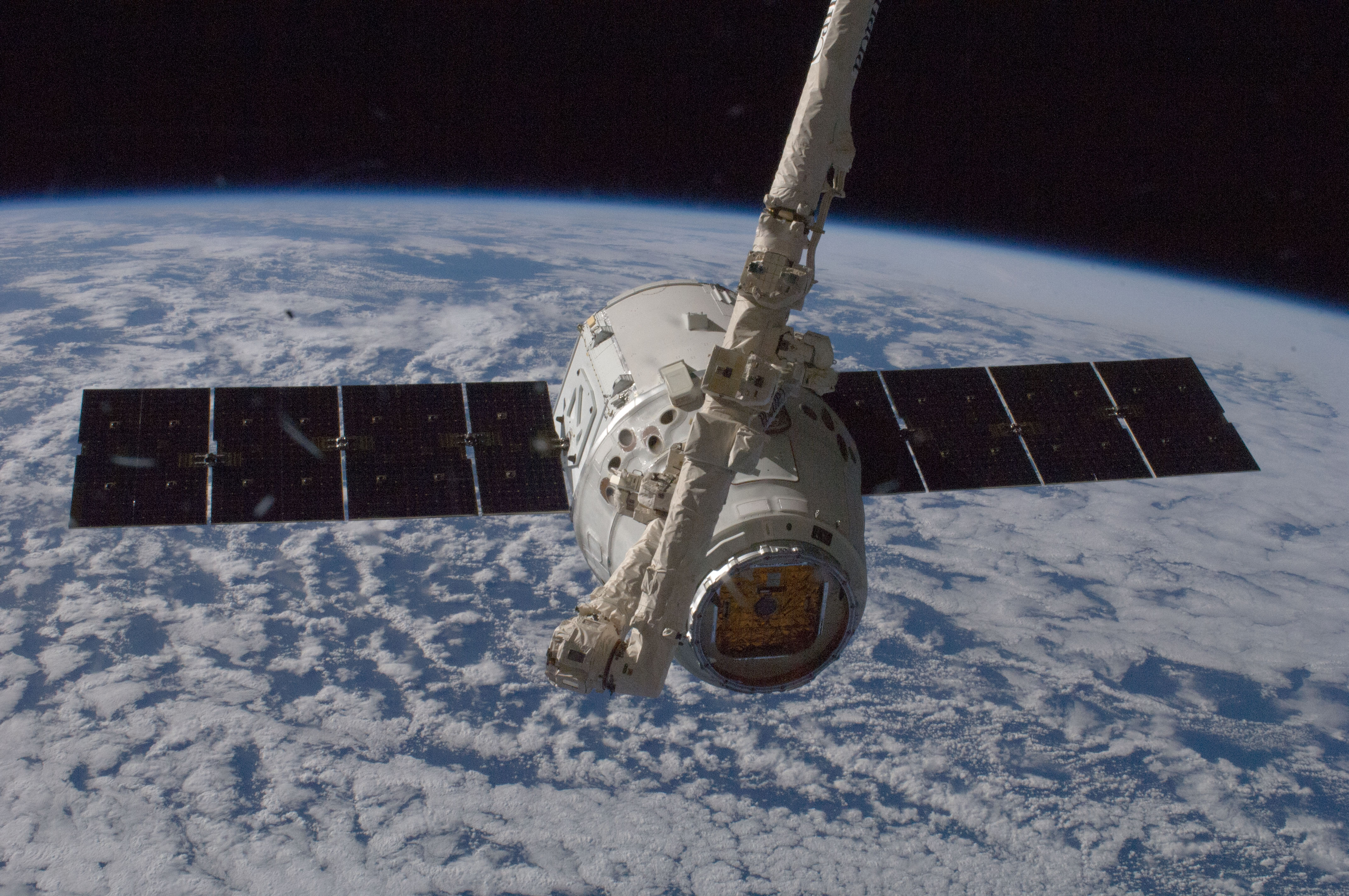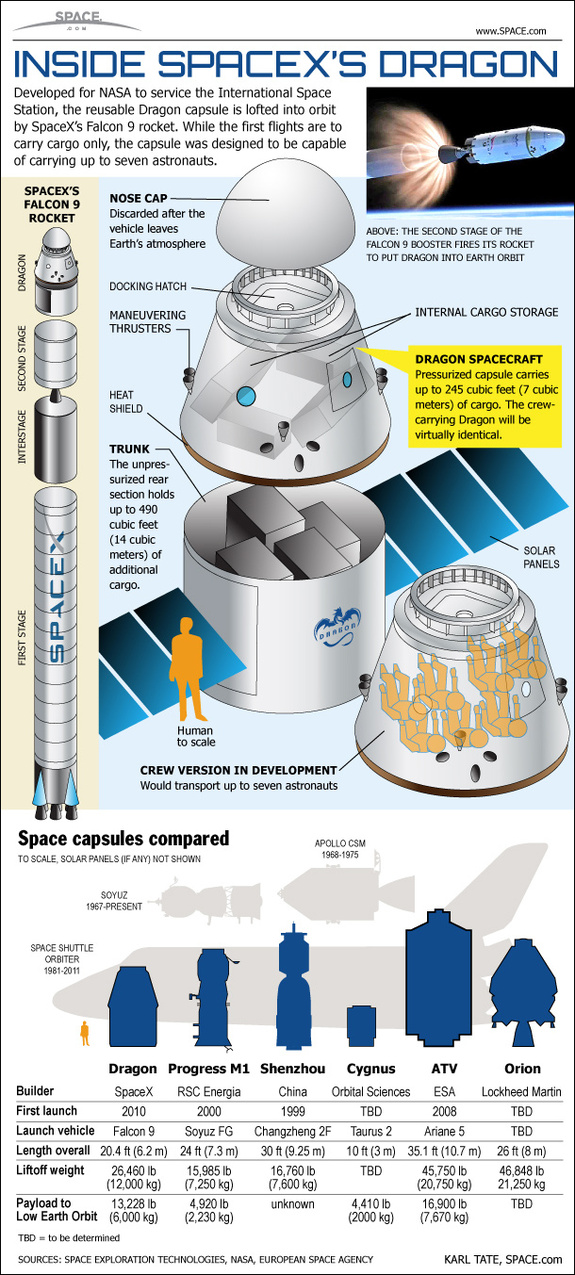
Working from the robotics workstation inside the seven-windowed Cupola, Japan Aerospace Exploration Agency astronaut Aki Hoshide, Expedition 33 flight engineer, with the assistance of NASA astronaut Sunita Williams, commander, captured Dragon at 6:56 a.m. (EDT) and used the robotic arm to berth Dragon to the Earth-facing port of the Harmony node Oct. 10, 2012
Credit: NASA
Space Exploration Technologies (better known as SpaceX) is the first company to ship private cargo to the International Space Station using its own rocket and spaceship, the Dragon. The California-based company has a lucrative contract with NASA to bring cargo to the station.
Additionally, the firm has customers from the private sector, military and non-governmental entities to launch cargo into space. As the company makes its money from launch services, SpaceX is firmly focused on developing technology for future space exploration.
The company is developing what will be the world’s most powerful rocket if completed: the Falcon Heavy. Additionally, founder Elon Musk has publicly speculated about the possibility of Mars colonies .
Musk’s fortune
Musk made his fortune very early in life: by age 30, in 2002, he had accumulated a reported $300 million and was looking for his next big venture.
According to the New York Times, his money came from the sale of two companies: Zip2, which was bought for $307 million in 1999, and PayPal, which eBay purchased for $1.5 billion in 2002.
Initially, Musk had the idea of sending a greenhouse to the Red Planet, dubbed the “Mars Oasis.” It was supposed to drum up public interest in exploration while also serving as a science base. The cost ended up being too high, so instead he decided to start a launching company: SpaceX.
Musk spent a third of his reported fortune — $100 million — to get SpaceX going. At the time, there was a certain amount of skepticism that he would ever be successful, and this persisted into SpaceX’s first years.
After spending 18 months toiling privately on a spacecraft, it was released to the public in 2006 under the name “Dragon.” Musk reportedly named the Dragon spacecraft after the song “Puff, the Magic Dragon ,” a 1960s song from folk group Peter, Paul and Mary. He chose the name because critics believed his spaceflight aims were impossible.
Falcon 1 flight
But Musk, a founder of several companies, already had years of business planning behind him. He sought out a stable customer — NASA — who could give funds for the early development of a rocket. Then he wooed launch clients from various sectors to diversify his customer base.
Musk firmly believed that more frequent and more reliable launches would bring down the cost of exploration. As such, his first goal for SpaceX was development of the Falcon 1 rocket.
That alone was an ambitious milestone, as the rocket would be the first privately built, liquid-fueled booster to make it into orbit. The company experienced a steep learning curve on the road to orbit.
It took four tries to get Falcon 1 flying, with previous attempts derailed by problems such as fuel leaks and a rocket stage collision.
“As the saying goes, the fourth time’s the charm,” Musk told his company of 500 workers on Sept. 28, 2008. “This is one of the best days of my life.”
By this point, SpaceX’s technology had the full attention of NASA. The company received a $278 million deal in 2006 to demonstrate the ability to send and return cargo to and from the space station. Four months after Falcon 1 first flew successfully, NASA awarded SpaceX a further contract for 12 station resupply flights.


A look inside the SpaceX Dragon capsule and its Falcon 9 rocket.
Credit: Karl Tate/SPACE.com
Enter the Dragon
Flying the Dragon spacecraft would require more rocket power, so SpaceX proposed developing the Falcon 9 rocket to send Dragon into orbit. SpaceX initially hoped to fly the spacecraft by 2008 or 2009, but the process took years longer than the company thought.
Both spacecraft and rocket were ready in 2010. Falcon 9 flew with a simulated Dragon payload in June 2010. In December of that year, Dragon took flight for the first time and splashed down on Earth safely.
The next and most crucial milestone was space station delivery. Dragon delivered its first truckload of cargo to the station in May 2012 under a test flight. The launch was scrubbed for a few days following an engine problem, but lifted off safely on the next try.
Regular cargo flights began with a mission in October 2012 that achieved most of its objectives, but experienced a partial rocket failure during launch that stranded a satellite on board. [Images: SpaceX Dragon Capsule’s 1st Cargo Flight to Station ]
SpaceX has made regular flights to ISS since then, but not without hiccups. Some critics have charged that SpaceX is not launching as regularly as promised. Also, in 2015, an explosion destroyed a Falcon 9 rocket bearing a Dragon spacecraft to the International Space Station. The cause was traced to a strut problem, grounding flights for several months.
Future thoughts
The company’s next major program goal for Dragon is to take people into space. The company is one of two funded under NASA’s Commercial Crew program. The crewed version of Dragon was unveiled to great fanfare that same year. SpaceX and its competitor, Boeing, are expected to take astronauts to the International Space Station around 2017 or 2018.
SpaceX is also attempting to build a reusable first stage of its Falcon 9 rocket. It has managed to recover the first stage after landing in water or on land, but several attempts so far to land on a barge have not been successful.,
But in all these years, Musk’s dreams of flying to Mars are undimmed.
In 2011, he told delegates at the American Institute of Aeronautics and Astronautics (AIAA) in San Diego that he plans to take people to Mars in 10 to 15 years. Three years later, at the International Space Development Conference, he said the reusable rocket stage would be a step to getting to the Red Planet .
“The reason SpaceX was created was to accelerate development of rocket technology, all for the goal of establishing a self-sustaining, permanent base on Mars,” Musk said at the time. “And I think we’re making some progress in that direction — not as fast as I’d like.”
Additional resources

Comments are closed.